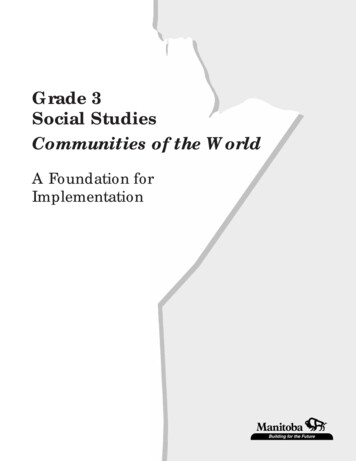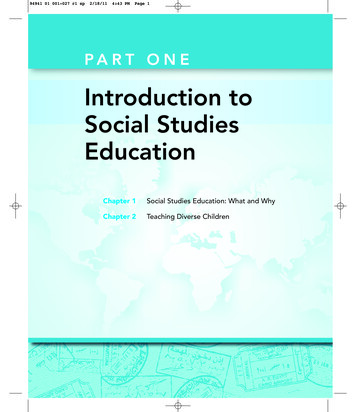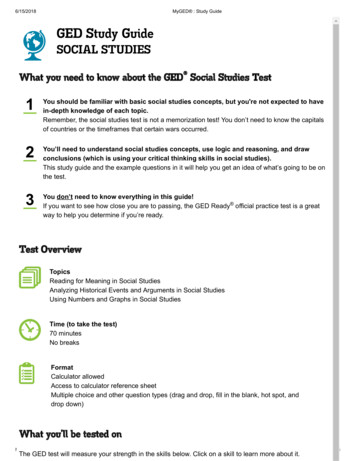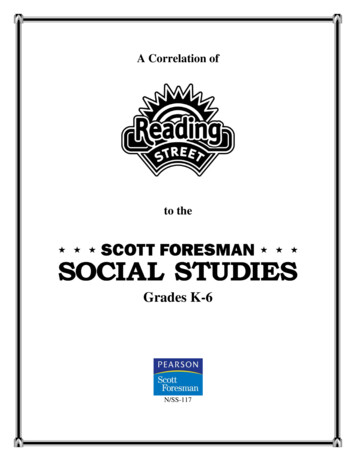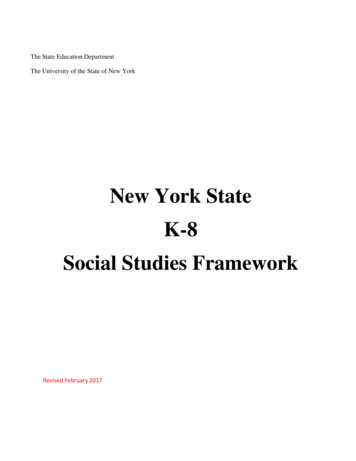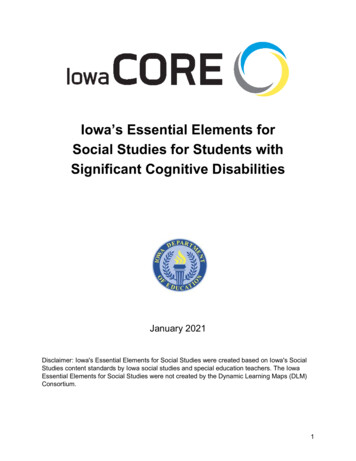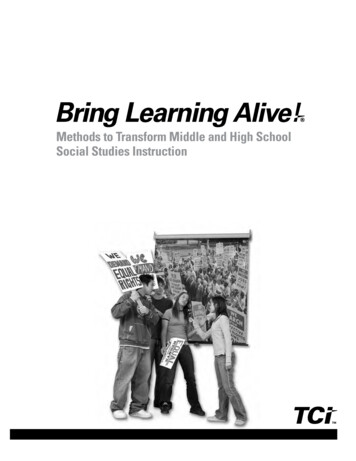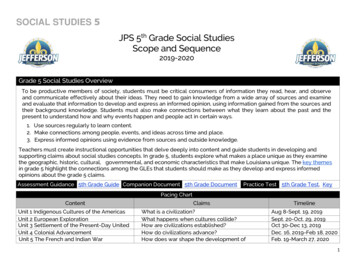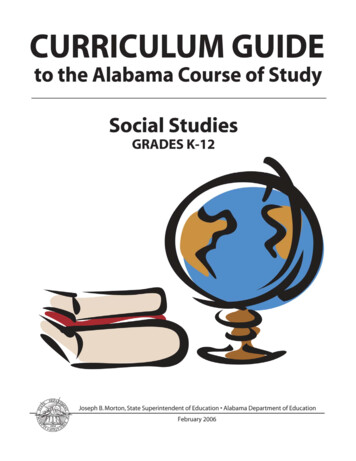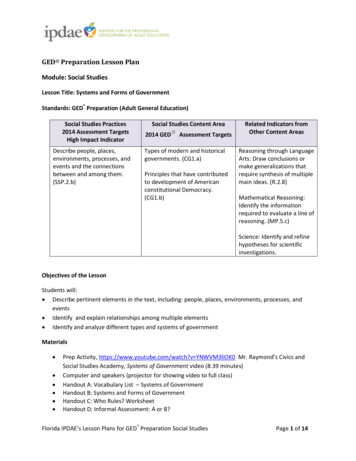
Transcription
GED Preparation Lesson PlanModule: Social StudiesLesson Title: Systems and Forms of GovernmentStandards: GED Preparation (Adult General Education)Social Studies Practices2014 Assessment TargetsHigh Impact IndicatorDescribe people, places,environments, processes, andevents and the connectionsbetween and among them.(SSP.2.b)Social Studies Content Area2014 GED Assessment TargetsTypes of modern and historicalgovernments. (CG1.a)Principles that have contributedto development of Americanconstitutional Democracy.(CG1.b)Related Indicators fromOther Content AreasReasoning through LanguageArts: Draw conclusions ormake generalizations thatrequire synthesis of multiplemain ideas. (R.2.8)Mathematical Reasoning:Identify the informationrequired to evaluate a line ofreasoning. (MP.5.c)Science: Identify and refinehypotheses for scientificinvestigations.Objectives of the LessonStudents will: Describe pertinent elements in the text, including: people, places, environments, processes, andevents Identify and explain relationships among multiple elements Identify and analyze different types and systems of governmentMaterials Prep Activity, https://www.youtube.com/watch?v YNWVM3liOK0 Mr. Raymond’s Civics andSocial Studies Academy, Systems of Government video (8.39 minutes)Computer and speakers (projector for showing video to full class)Handout A: Vocabulary List – Systems of GovernmentHandout B: Systems and Forms of GovernmentHandout C: Who Rules? WorksheetHandout D: Informal Assessment: A or B?Florida IPDAE’s Lesson Plans for GED Preparation Social StudiesPage 1 of 14
Instructional PlanOverviewThe GED Social Studies test focuses on the fundamentals of social studies reasoning including a deepconceptual understanding of social studies content, procedural skill and fluency, and the ability to applythese fundamentals in realistic situations. Describing people, places, environments, processes, andevents and the connections between and among them, is one of the identified skills that are key toreasoning in both textual and quantitative social science contexts. This lesson draws from the contentdomain of civics and government, which comprises approximately 50% of the social studies content andreflects what is most relevant and useful for an adult population. The GED Testing Service hasidentified this assessment target as a high impact indicator that describes some of the critical thinkingskills students need to be successful in college, career training, and the workforce.ProcessIntroduce the lesson by asking the following questions and discussing as a class: What kind of system of government does the United States have?How is the US system like the governmental systems of other countries?Name some different forms of government and how do their characteristics differ from the USsystem?Show the YouTube video from Mr. Raymond’s Civics and Social Studies Academy, Systems ofGovernment video https://www.youtube.com/watch?v YNWVM3liOK0 (8.39).After viewing the video, lead class discussion and answer the following questions: What are some of the pros and cons of a democracy?Who holds the most power in a monarchy?Name an example of a parliamentary style of government?Would you want to live in a theocracy? Why or why not?Review vocabulary definitions on Handout A: Vocabulary – Systems of Government. Be sure to mentionthe example countries for each system. You may also want to ask students to locate each country on aworld map.After the vocabulary review, give students Handout B: Systems and Forms of Government. Completeone item from each section together and then have students complete worksheet through number 12.Sample Debriefing Questions Other than a democracy, which form or system of government might you choose to live under?Are there some disadvantages to democratic rule and if so, what are they?Florida IPDAE’s Lesson Plans for GED Preparation Social StudiesPage 2 of 14
Modifications for Different LevelsTo modify instruction, provide students with samples from social studies texts, and have them work inpairs to list the pros and cons of the different types of governmental systems in the world.Then have one student brainstorm a scenario, while the other students try to name the type ofgovernment the situation describes. Below are some examples. A town has no government at all. All citizens may do whatever they believe is in their own bestinterest.This city is controlled by the clergy of the religious center. The clergy makes all of the decisionsand the citizens follow these orders.In the country of Equality, the citizens vote on and elect new members to serve on the rulingcouncil every three years. Those members elect a leader from their ranks to serve as thesupreme ruler, who serves as long as the ruling council feels he or she is doing as they wish.Assessments/ ExtensionsThroughout the lesson, be sure to monitor and check for student understanding for each new conceptor vocabulary term. Allowing students to work in pairs helps to build confidence and share knowledge.There are several resources available on the internet, as well in the GED preparation materials, whichwill give students more practice with GED type questions that deal with the civics and governmentsections of the test. Provide students with Handout C: Who Rules? as an extension activity for studentsto apply their knowledge.Provide students with Handout D: Informal Assessment: A or B? as an informal assessment. Discuss thestudents’ answers and their reasons for each.Florida IPDAE’s Lesson Plans for GED Preparation Social StudiesPage 3 of 14
Handout AVocabulary ListSystems of Government1) Federal – Power is shared by powerful central government and states or provinces aregiven considerable self- rule usually through their own legislatures* United States, Australia, Federal Republic of Germany2) Unitary – One central government controls weaker states. Power is not shared betweenstates, countries or provinces.*China, United Kingdom3) Confederal – Weak or loose organization of states agrees to follow a powerful centralgovernment. Nations can choose to follow or not follow the lead of the weak centralgovernment.* The Commonwealth of Independent States(CIS) formerly known as the Soviet Union,Switzerland’s canton system, Confederate States of America (1861-1865)4) Parliamentary – A system of government where power lies with the legislative body and theleader of the country is part of the legislature and remains in power as long as his/her partyremains.*Denmark, Sweden, JapanTypes of Government5) Autocracy – A form of government where one person has unlimited power. There are twomain types of autocracy – a monarchy or a dictatorship.*North Korea, United Arab Emirates6) Absolute Monarchy – A form of autocracy where a person becomes the sole leader of acountry by being born into a family of rulers.*Saudi Arabia, Brunei, Vatican CityFlorida IPDAE’s Lesson Plans for GED Preparation Social StudiesPage 4 of 14
7) Monarchy – Headed by a king or queen who inherits the position, rules for life, and holdspower that can range anywhere between limited to absolute.* United Kingdom, Belize, Sweden8) Dictatorship – One leader has absolute control over citizen’s lives. There is no citizenrepresentation.*Zimbabwe, Uzbekistan9) Oligarchy – A form of government in which a small group has total control and power.*China, Venezuela10) Democracy – The government is elected by the people. People either vote on issues directly(direct democracy) or they elect representatives who make government decisions for them(representative democracy). In a democracy, people enjoy certain basic rights.*United States, Iceland, India11) Theocracy – A form of government in which God or a deity is recognized as the supremecivil ruler.*Iran, Afghanistan12) Anarchy – The absence of any form of government.* SomaliaFlorida IPDAE’s Lesson Plans for GED Preparation Social StudiesPage 5 of 14
Handout BSystems and Forms of GovernmentFrom the word list below, select the correct form or system of government for each situation.FederalUnitaryConfederalParliamentary1) Countries like the United States have a strong powerful central government with states orprovinces that also have representational self-rule.2) The citizens in this system of government vote and elect members of the legislative body, butthat body itself elects the ruler or leader of the country.3) Though not common, this governmental system contains a weak organization of states and aweaker central government.4) The leaders of the countries with this system are part of the legislature and only remain inpower as long as the party they represent is in power.5) States or provinces under this form do not have power of their own instead having onecentral government that controls everything.Florida IPDAE’s Lesson Plans for GED Preparation Social StudiesPage 6 of 14
From the word list below, select the correct form or system of government for each situation.AutocracyAbsolute cracyAnarchy6) Which form of government is utilized in North America and India?7) The citizens of these countries are generally strongly religious and the ruling leader is alsooften the religious leader of the county.8) No one is in control under this governmental system.9) A small group of people have all the power under this system.10) A king or a queen inherits their position as ruler from birth but their powers can range fromvery strong to quite weak.11) Monarchies and Dictatorships where one person has the power are two types of this formof government.12) A system of government when citizens have no representation and everything aspect of lifeis controlled by one leader.Florida IPDAE’s Lesson Plans for GED Preparation Social StudiesPage 7 of 14
Handout BAnswer Key: Systems and Forms of Government1) Countries like the United States have a strong powerful central government with states or provincesthat also have representational self-rule.Federal2) The citizens in this system of government vote and elect members of the legislative body, but thatbody itself elects the ruler or leader of the country.Parliamentary3) Though not common, this governmental system contains a weak organization of states and a weakercentral government.Confederal4) The leaders of the countries with this system are part of the legislature and only remain in power aslong as the party they represent is in power.Parliamentary5) States or provinces under this form do not have power of their own instead having one centralgovernment that controls everything.Unitary6) Which form of government is utilized in North America and India?Democracy7) The citizens of these countries are generally strongly religious and the ruling leader is also often thereligious leader of the county.Theocracy8) No one is in control under this governmental system.Anarchy9) A small group of people have all the power under this system.Oligarchy10) A king or a queen inherits their position as ruler from birth but their powers can range from verystrong to quite weak.Monarchy11) Monarchies and Dictatorships where one person has the power are two types of this form ofgovernment.Autocracy12) A system of government when citizens have no representation and every aspect of life is controlledby one leader.DictatorshipFlorida IPDAE’s Lesson Plans for GED Preparation Social StudiesPage 8 of 14
Handout CWho Rules? WorksheetiCivics Website https://www.icivics.orgFlorida IPDAE’s Lesson Plans for GED Preparation Social StudiesPage 9 of 14
Florida IPDAE’s Lesson Plans for GED Preparation Social StudiesPage 10 of 14
Handout CWho Rules? Worksheet Answer KeyiCivics Website https://www.icivics.orgFlorida IPDAE’s Lesson Plans for GED Preparation Social StudiesPage 11 of 14
Florida IPDAE’s Lesson Plans for GED Preparation Social StudiesPage 12 of 14
Handout DFlorida IPDAE’s Lesson Plans for GED Preparation Social StudiesPage 13 of 14
Handout DAnswer Key: Informal Assessment: A or B?Florida IPDAE’s Lesson Plans for GED Preparation Social StudiesPage 14 of 14
The GED Social Studies test focuses on the fundamentals of social studies reasoning including a deep conceptual understanding of social studies content, procedural skill and fluency, and the ability to apply these fundamentals in realistic situations

